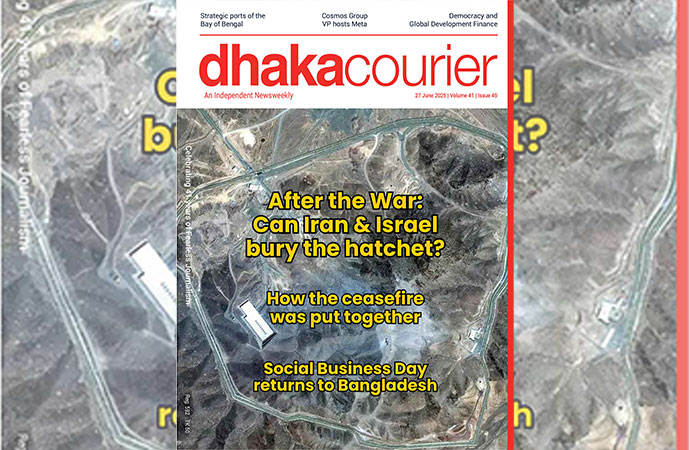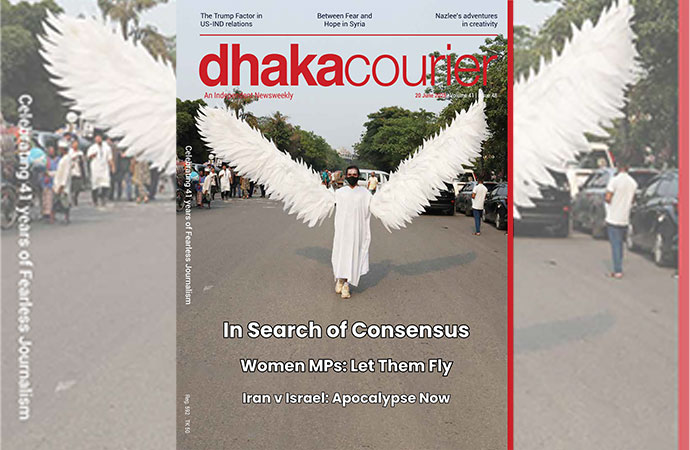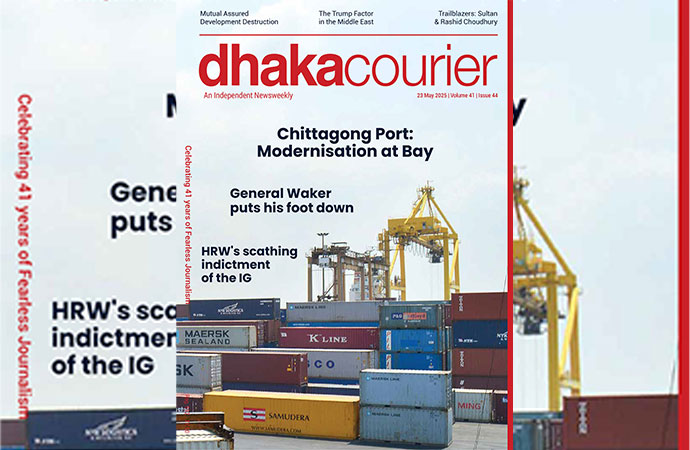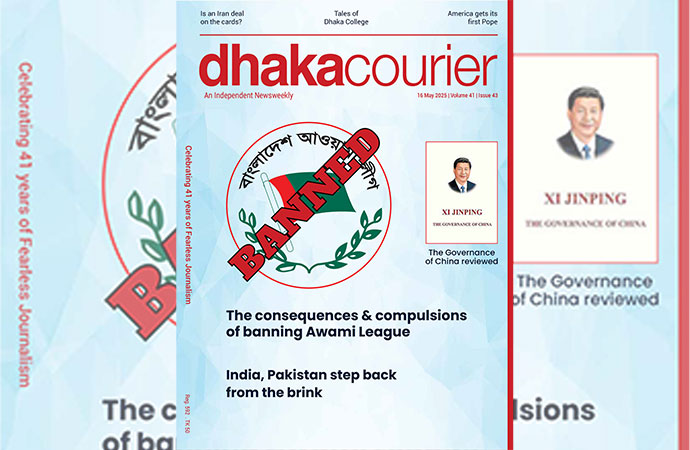Reportage

In its search for export diversification beyond the apparel sector that rakes in an almost obscene 85 percent of the country's foreign exchange earnings each year, Bangladesh has long held on to the promise of its leather sector. It was around the middle of the present decade that all that promise finally looked set to come good, when in May 2014, the Bangladeshi leather sector crossed the $1 billion mark in annual export earnings for the first time.
Compound annual growth for the preceding five years had been over 25 percent, and there were early signs that the industry was moving towards higher value-added production, more diversified export markets, and innovative new products. Even the composition of exports within the sector among three categories of products - finished leather, leather goods, and footwear - had shifted favourably, as earnings surged in the higher value-added categories of leather goods and footwear.
The sector would go on to repeat the $1 billion-mark export earnings in three consecutive fiscals - still the only one outside RMG - culminating in 2017's "Product of the Year" award, announced by no less a figure than Prime Minister Sheikh Hasina herself at the inauguration of that year's Dhaka International Trade Fair.
"The government wants to boost up the rising leather sector to explore its full potential," the prime minister had said, while announcing the award. She went on to ask all concerned to take whatever steps were necessary to support, incentivise and boost the leather sector.
For all the good intentions though, the great expectations have been belied. The last two fiscals have seen exports actually decline, first by 12 percent in 2017-18, then 6 percent in 2018-19, to just about crawl across the billion-dollar mark. Various factors played into this, that we shall come to. But one particularly unseemly episode that played out in the days following Eid ul Adha, and in fact is still unfolding to some extent, served to really draw the public's attention in a negative way: the absolute collapse in the price of rawhide - the primary input for the entire leather sector - that particularly affected the seasonal traders who do the bulk of their business in the post-Eid ul Adha period. It led to the unprecedented situation that witnessed seasonal traders across the country literally throwing away, or burying (yes, literally) thousands of pieces of rawhide of the sacrificial animals from Eid ul Adha, after failing to sell them for a lack of demand.
The traders and rawhide merchants put the prices of the dumped rawhide at around Tk 100 crore. The drastic fall in rawhide prices forced seasonal traders in different districts, including Dhaka, Chattogram, Narayanganj, Narsingdi, Sylhet, Rajshahi and Khulna, to throw away thousands of pieces of rawhide of cows, goats and buffaloes sacrificed during Eid-ul-Adha.
Many also buried the rawhide underground failing to get the expected prices while others sold them at throwaway prices. Talking to our sister newsagency UNB, a number of seasonal traders said cowhide was sold for between Tk 100-200 per piece this year, whereas the usual price was around Tk 2,000.
Rezaul Bepari, a seasonal rawhide trader from Shariatpur, said he bought 200 pieces of rawhide this year at Tk 150-Tk 250 apiece but wholesalers offered him less than the purchasing prices for those. "I have been doing the business for many years. Once there's a huge demand for rawhide and it was a profitable business. But the price is now very low. Besides, there's no value of goat hide this year," he said.
Meanwhile, madrasahs and orphanages that receive thousands of pieces of rawhide in donations from the public during Eid-ul-Adha, also failed to sell them on due to "reluctance from merchants".
Mufti Monirul Islam, a teacher of Qawmi madrasa in Keraniganj, said they used to earn "several lakh taka" from the sale of rawhide every year in the past, which could meet almost 70 percent of the madrasa's expenses. "But we could manage little money from rawhide sales this time due to the cheap rate. We're worried about bearing the cost of the orphanage this year."
Such factors serve to make what is clearly a case of market failure an almost emotive issue in bangladesh. It probably explains why something that has been foreshadowed for a number of years now, still ended up catching everyone off guard and scrambling for a response. The truth is that rawhide prices have been falling for almost a decade or even more now. The trend continued even through the peak mid-decade years of the leather sector. Some of the headlines from that period in various national dailies make eerily similar reading: 'Rawhide sold at lowest prices' (2016), 'Rawhide traders suffer for low prices' (2015), and 'Rawhide prices lowered by 16 percent' (2014).
It may be mentioned that the 16 percent decrease in 2014 set the prices at Tk70-75 per square foot of raw cow hide in the capital and Tk 60-65 across the rest of the country. The following year saw an even more drastic slashing of the prices - by close to 35 percent. By 2018, the prices had really hit rock bottom. This year the government set the corresponding prices at Tk 45-50 and Tk 35-40 respectively (more or less unchanged since last year), and even those have been flouted.
After the fall
The good news for now however, is that although the preceding two years' performance has served to take some of the shine off the leather sector's promise, there are clearly identifiable reasons behind the slowdown in the export segment that served to push the primary stage rawhide trade over the edge. One pivotal event that almost everyone points to is the much-heralded shift of the country's tannery industry from Hazaribagh to a dedicated site in Savar. While no-one doubts the sheer necessity and wisdom behind the shift (apart from gaining Hazaribagh notoriety as one of the most polluted places on the planet, this dubious distinction was affecting orders from international buyers as well), the way it was ultimately forced through under then Industries Minister Amir Hossain Amu in 2017 was clearly not designed to minimise disruption. In fact, it has been a disaster, and the government - with the Bangladesh Small and Cottage Industries Corporation (BSCIC) that acted as the executing agency on its behalf - must squarely take the blame for it.
Initiated in 2003, the 200-acre park in Savar is still without a fully functional Central Effluent Treatment Plant (CETP), while the work on a dumping yard is yet to even begin. The authorities have also reportedly failed to hand over the land deeds to any of the tanneries that have moved there till now. Given what was promised by the government prior to the shift as its end of the bargain, and the importance of the industry plus the stage it was at, this is all pretty shocking. Far from heralding a new, more prosperous era, the shift to Savar can now instead be likened to shooting it down, just as it took flight. If that doesn't merit an inquiry to hold the people who were responsible for this botched relocation to account, nothing ever will.
Recognised foreign brands do not purchase goods made of Bangladeshi leather as the country's industrial park - even lacking a full-fledged CETP -is not environment-friendly. That is causing even local footwear manufacturers like Apex to import the leather they use in their footwear (that explains the footwear sub-sector's growth in exports bucking the trend).
Even three years ago, local factories used to export leather goods to European markets. But word got around among the buyers' community on Bangladesh's continued environmental issues, and that was it. That is when Apex and some other leather goods manufacturers had to shift to importing leather, in order to continue supplying international markets.
"We are not environmentally compliant. This is because of the absence of full-fledged operation of CETP. Moreover, the Leather Working Group (LWG) certification, which makes it easier to sell goods to the global buyers, is hard to come by for us, due to the absence of a fully operational CETP," said Md Saiful Islam, managing director of PICARD Bangladesh Limited, in an interview last July.
The certification from the LWG is subject to environmental compliance and performance capabilities. Furthermore, many tanneries are yet to start functioning even, following the shift. At present, only 124 out of 158 tanneries that were shifted out of Hazaribagh are actually operating.
On the turning away
Once we recognise the incredibly difficult spot in which the tanneries have been put by the government's ineptitude and negligence, they no longer emerge as the villains of the piece as far as the rawhide crisis is concerned. Indeed, reports were coming out weeks before Eid ul Adha about a potential cash flow crisis, due to unpaid debts of over Tk 350 crore accumulated over the last four years by the tanners, the bulk of the amount accruing since the shift to Savar.
The Bangladesh Tanners Association (BTA) has been sounding out that the sector is in serious fund crisis as they had to make huge investments for relocating to Savar, and that they were trying to manage funds from various sources including bank loans prior to Eid. While the tanners were trying to manage these loans, suppliers of rawhides were waiting for funds from the tanners. The wheel never turned for either evidently, resulting in the disastrous consequences that played out in front of the whole nation following Eid.
For now, it is being said that the crisis is all set to be resolved with the tanners starting to enter the market to buy in accordance with the decision of a tripartite meeting held on August 19. As part of the move, the Federation of Bangladesh Chambers of Commerce and Industry (FBCCI) has been given the responsibility to hold a meeting with rawhide and skin merchants and tanners by August 22. Also, the government is planning to formulate a 'rawhide and skin policy' to resolve the crisis in the leather industries.
Industries Minister Nurul Majid Mahmud Humayun and Salman F Rahman, the prime minister's private sector and investment adviser, will work for resolving the issues that crop up.
Apart from them, senior secretary in the Commerce Ministry Mofizul Islam, leaders of Bangladesh Tanners' Association (BTA) and Bangladesh Hide and Skin Merchants Association (BHSMA) attended the meeting, among others. Nurul Majid said only 10,000 pieces of rawhides and skin have been damaged, which he termed 'insignificant'.
"The FBCCI leaders will hold a meeting with the leaders of the Bangladesh Tanners' Association (BTA) and the Bangladesh Hide and Skin Merchants Association (BHSMA) on August 22 to settle the monetary crisis and dues of rawhide and skin traders. If the FBCCI leaders fail to reach a concrete decision, then the ministry concerned will take the responsibility," said Rahman, also the vice chairman of leading conglomerate Beximco Group.
"Around 1 crore pieces of rawhides are produced during Eid-ul-Azha. Normally 5,000 pieces of rawhides are damaged every year. This year, only 10,000 pieces of rawhides were damaged," he added.
Delwar Hossain, president of BHSMA, also said the skin merchants in Dhaka and outside have around Tk 400 crore dues in dues owed to them by the tanners. "We hope the tanners will pay our arrears shortly."
On August 17, BHSMA had decided to keep the rawhide sales to the tanners suspended until their arrears are paid. The Industries Minister said a plot is on to harm the progress of leather industry. "But today's meeting is successful as we've been able to solve the prevailing problems."
He said around 1 crore rawhides are supposed to be collected this year, and 10,000 of them might have damaged for various reasons. About the crisis over the dues of skin merchants, the minister said they never came up with such complaints earlier. "The FBCCI has been given the task to realise the arrears from the tanners."
He said the FBCCI is scheduled to hold a meeting with the tanners and skin merchants on August 22 to solve the problem. Majid also said the government is working to formulate guidelines for the leather industry.
Salman F Rahman, also an MP these days, reportedly played a key role in the meeting. Certainly he was by far the most powerful and influential figure present, despite the industries minister. Mr Rahman said the government will work to "develop the leather sector" in the days to come. Having undone so much of the years of good work done in the sector, it is the least they can do.

























Leave a Comment
Recent Posts
Cosmos Group VP Nahar Khan hos ...
A visiting delegation from Meta, the parent company of Facebook, Insta ...
Break the gloom, build a bette ...
Emphasising the transformative power of social business and its strong ...
‘Mobocracy’ must not prevail
The US Supreme Court allowed the Trump administratio ..
Germany dependable partner in our development journe ..
15th edition of Social Business Day: Prof Yunus to j ..